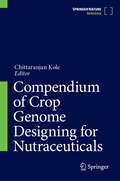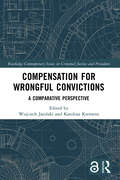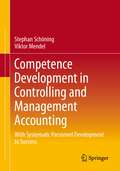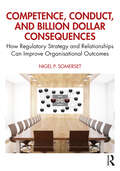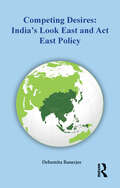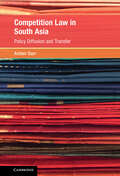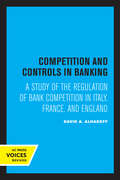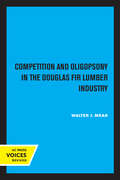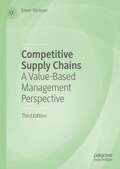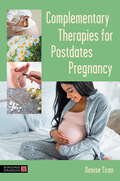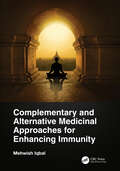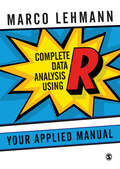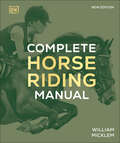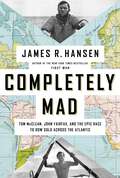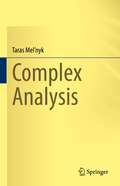- Table View
- List View
Compendium of Crop Genome Designing for Nutraceuticals
by Chittaranjan KoleThe crop plants cater not only to our basic F5 (food, feed, fiber, fuel, and furniture) needs but also provide a number of nutraceuticals with potential nutritional, safety and therapeutic properties. Many crop plants provide an array of minerals, vitamins, and antioxidant-rich bioactive phytochemicals. Increasing incidences of chronic diseases such as cancer, diabetes and HIV, and malnutrition necessitate global attention to health and nutrition security with equal emphasis to food security. This compendium compiles results of researches on biochemical, physiological and genetic mechanisms underlying biosynthesis of the health and nutrition related nutraceuticals. It also explores the precise breeding strategies for augmentation of their content and amelioration of their quality in crop plants under all commodity categories including cereals and millets, oilseeds, pulses, fruits and nuts, and vegetables. The compendium comprise 5 sections dedicated to these 5 commodity groups and presents enumeration on the concepts, strategies, tools and techniques of nutraceutomics. These sections include 50 chapters devoted to even number of major crop plants. These chapters present deliberations on the biochemistry and medicinal properties of the nutracuticals contained; genetic variation in their contents; classical genetics and breeding for their quantitative and qualitative improvement; tissue culture and genetic engineering for augmentation of productivity and quality; and sources of genes underlying their biosynthesis. They also include comprehensive enumeration on genetic mapping of the genes and QTLs controlling the contents and profile of the nutraceuticals and molecular breeding for their further improvement through marker assisted selection and backcross breeding tools. Prospects of post-genomic precise breeding strategies including genome-wide association mapping, genomic selection, allele mining, and genome editing are also discussed. This compendium fills the gap in academia, and research and development wings of the private sector industries interested in an array of subjects including genetics, genomics, tissue culture, genetic engineering, molecular breeding, genomics-assisted breeding, bioinformatics, biochemistry, physiology, pathology, entomology, pharmacognosy, IPR, etc., and will also facilitate understanding of the policy making agencies and people in the socio-economic domain and research sponsoring agencies.
Compensation for Wrongful Convictions: A Comparative Perspective (Routledge Contemporary Issues in Criminal Justice and Procedure)
by Karolina Kremens Wojciech JasińskiThis book presents a comprehensive comparative analysis of the substantive and procedural aspects of compensation for wrongful convictions in European countries and the USA, as well as the standard derived from the case law of the European Court of Human Rights. The collection draws comparative conclusions as to the similarities and differences between selected jurisdictions and assesses the effectiveness of the national compensation schemes. This enables the designing of an optimum model of compensation, offering accessibility and effectiveness to the victims of miscarriages of justice and being acceptable to jurisdictions based on common law, and civil law traditions, as well as inquisitorial and adversarial types of criminal process. Moreover, the discussion of the minimum European standard as established in the case law of the European Court of Human Rights enables readers to identify how the Strasbourg Court can contribute to strengthening the compensation scheme. The book will be essential reading for students, academics and policymakers working in the areas of criminal law and procedure.
Competence Development in Controlling and Management Accounting: With Systematic Personnel Development to Success
by Stephan Schöning Viktor MendelThe book is considered a guideline for systemic personnel development in controlling of nationally and internationally active companies on the basis of a targeted development of competencies. In particular, the challenges posed by digitalization and globalization are considered and substantiated with the help of empirical studies. Employees and managers in controlling as well as HR managers in companies gain a deeper understanding of the necessity and the components of systematic personnel development. The goals are the formation of high-performance teams in controlling as well as the identification of personal career paths on the way to top management tasks as CFO. The focus of the personnel development model is on the transfer of the competence-oriented development approach, which, in addition to the traditionally considered technical and methodological competencies, also takes into account social and personal competencies as well as additional digital and intercultural competencies. The book is rounded off by a survey of the current situation, the definition of a target situation to be aimed at, the discussion of suitable further training measures and the monitoring of the level of competency achieved, and illustrates concrete career concepts.
Competence, Conduct, and Billion Dollar Consequences: How Regulatory Strategy and Relationships Can Improve Organisational Outcomes
by Nigel P. SomersetThis practical guide to understanding how regulators build insight and form judgements will help organisations to develop their strategy and approach to engagement and to improve their regulatory outcomes. From robot-assisted surgery and advances in stem cell technology, the explosion in use of social media and advances in computing power to the development of autonomous vehicles and digital environments such as the metaverse, these exciting developments present questions, invite debate and have implications. These rapid new developments also join a world described as being increasingly VUCA (volatile, uncertain, complex, and ambiguous), making industry-regulator relationships more important than ever to prevent consumer harm and to configure business success. This book is written for those who wish to build positive and progressive relationships with their regulators in these exciting times of rapid advancement. From developing their strategy, through to the practicalities of how to prepare and engage with regulators, readers are navigated through an ecosystem of insight to help build an understanding of what informs their regulator’s opinion and judgements. Underpinned with real-world experiences and examples, this book shows that, through clearer strategic focus and more effective relationships, organisations can refine their approach and build their relationships to drive mutually beneficial regulatory relationships that avoid negative consequences and unnecessary costs. Board members, executives, senior leaders, risk, compliance, legal professionals, regulators, and students of business, finance, and law will refer to this book again and again to guide holistic thinking about regulatory relationships and use the insights these can provide to help them calibrate their actions, activities, and progress.
Competing Desires: India’s Look East and Act East Policy
by Debamita BanerjeeIndia’s Look East policy opened up a new strategic dimension to Indian foreign policy. India had significant cultural and diplomatic linkages with the Southeast Asian nations. But India’s non-aligned diplomatic position created a distance between India and Southeast Asia. The adoption of the Look East Policy led to the establishment of economic and strategic ties with Southeast Asia. The policy was revised in the form of the Act East Policy in 2015 in the face of China’s increasing influence in South and Southeast Asia which posed a threat to India’s security. Moreover the Sino-Pakistan liaison necessitated the strengthening of India-Southeast Asia relations. This book is an attempt to trace the development of the Look East Policy, its transition into Act East Policy and its aftermath. These changing parameters will show the decisive impacts on the transformative phases of India’s foreign policy.
Competition Culture and Corporate Finance: A Measure of Firms’ Competition Culture Based on a Textual Analysis of 10-K Filings
by Terry HarrisThis book introduces a measure of firms’ competition culture based on a textual analysis and natural language processing (NPL) of firms’ 10-K filings. Using this measure, the book explores the relationship between competition culture and various phenomena in corporate finance, specifically, institutional ownership structure, stock return performance, idiosyncratic stock price crash risk, meeting/beating analysts’ earnings expectations, and earnings management activity, for a large sample of US-based financial and non-financial firms. In particular, the book provides evidence that transient institutional ownership intensifies firms’ competition culture, while dedicated institutional ownership lessens it. In addition, the book’s findings suggest that firms with greater levels of competition culture achieve higher levels of short-term stock return performance, experience greater incidence of idiosyncratic stock price crashes, and are more prone to meet/beat analysts forecast and engage in accruals-based earnings manipulation. Finally, the book examines the role played by competition culture in financial firms (i.e., banks). Specifically, the book explores the effect of competition culture on bank lending and shows that banks with greater levels of competition culture are generally more prone to engage in procyclical lending activity. The findings of the book have significant policy implications and will be of interests to regulators, accounting standard-setters, managers and those charged with firm governance, career academics and researchers, graduates, and those generally interested in the role played by corporate culture in the related fields of finance, economics, and accounting.
Competition Law in South Asia: Policy Diffusion and Transfer (Global Competition Law and Economics Policy)
by Amber DarrIn the last twenty years, South Asian countries have increasingly engaged with modern competition legislation. Yet, apart from India and Pakistan, the countries in this region have had little success enforcing these laws. Competition Law in South Asia analyses the mechanisms and institutions through which Bangladesh, Bhutan, India, Pakistan, Maldives Nepal, Sri Lanka, and Afghanistan have engaged with modern competition legislation. The book argues that the success (or failure) of competition reform in these countries is inextricably linked to the unique interplay of mechanisms and legal and political institutions through which these countries have engaged with competition legislation. The book provides an in-depth comparative analysis of the adoption and implementation continuum in India and Pakistan, the compatibility and legitimacy generated by the adoption process, and its impact on implementation. Taking a far-reaching, comparative approach, the book draws lessons not only for countries in South Asia but also for emerging economies across the globe.
Competition Law in Switzerland: Law and Practice in a European Context
by Pranvera KëlleziThis is the first comprehensive English-language overview of competition law enforcement in Switzerland since the introduction of direct sanctions in 2004. It discusses the key issues facing practitioners: horizontal and vertical agreements (with a particular emphasis on distribution agreements), abuse of dominance, and the newly introduced provisions on relative market power and merger control. It also provides an overview of the key procedural provisions, leniency and amicable settlements, and fines. The book subsequently analyses the main differences between Swiss and EU competition law and explains why, to what extent, and how companies should conduct a separate analysis under Swiss law. It offers a comprehensive overview and accessible analysis, based on in-depth research of case law, for practitioners and in-house counsels who need to ensure compliance with competition law on a Swiss, European or international basis. It is also a valuable guide for all practitioners, academics and students interested in understanding Swiss competition law. Enforcement of competition law in Switzerland has intensified and is becoming increasingly important for global companies selling in Switzerland. Moreover, the fines have increased over the last twenty years, and many foreign companies have had to pay substantial fines in recent years. Lastly, the Swiss Federal Supreme Court has now extended the extraterritorial application of Swiss competition law to foreign companies where sales to Switzerland are possible.
Competition and Controls in Banking: A Study of the Regulation of Bank Competition in Italy, France, and England
by David A. AlhadeffThis title is part of UC Press's Voices Revived program, which commemorates University of California Press’s mission to seek out and cultivate the brightest minds and give them voice, reach, and impact. Drawing on a backlist dating to 1893, Voices Revived makes high-quality, peer-reviewed scholarship accessible once again using print-on-demand technology. This title was originally published in 1968.
Competition and Intellectual Property Law in Ukraine (MPI Studies on Intellectual Property and Competition Law #31)
by Heiko RichterThis volume provides the most comprehensive contemporary academic writing on Ukrainian competition and intellectual property law in English. Especially over the last few years, these areas have been in considerable flux, a main driver being the EU–Ukraine Association Agreement. The chapters cover a broad range of different topics and share a forward-looking perspective. They also outline the basic background that is necessary to understand the context of the issue discussed, especially with regards to the legal system of Ukraine. The publication is the result of a two-year project, and it is addressed to a wide range of international scholars, practitioners, and policy makers. It aims to make the state-of-the-art in Ukrainian legal scholarship visible and accessible to the international research community and to stimulate global debates in academia and politics. Therefore, it may be of interest and use to anyone who is interested in competition and intellectual property law, and/or in Ukraine.
Competition and Oligopsony in the Douglas Fir Lumber Industry
by Walter J. MeadThis title is part of UC Press's Voices Revived program, which commemorates University of California Press’s mission to seek out and cultivate the brightest minds and give them voice, reach, and impact. Drawing on a backlist dating to 1893, Voices Revived makes high-quality, peer-reviewed scholarship accessible once again using print-on-demand technology. This title was originally published in 1966.
Competitive Digital Innovation: Transforming Products, Processes and Business Models to Win in the Digital Economy (Palgrave Executive Essentials)
by Amit Basu Steve MuylleInnovative digital technologies are forcing companies to rethink how they compete. The focus of digital innovation in business has shifted from internal transformation within firms to their market interface and ecosystems. While opportunities for innovation in internal operations are well established, it’s less clear how to leverage technology at the market interface. This often has strategic implications, and the goal of this book is help you connect digital innovation to business strategy. By understanding how to leverage digital technologies, you can redefine your market-facing business processes, your products, services and even your business models and stay competitive in today’s hybrid markets. This book provides a coherent and comprehensive approach to not just survive but rather thrive in the 21st Century global marketplace. With global, real-world examples and original frameworks, this is an ideal book for executives and anyone who wants to understand digital strategy. Highly practical but infused with rigorous research, it shows you how your business can use digital technologies to compete in today’s hybrid markets.
Competitive Supply Chains: A Value-Based Management Perspective
by Enver YücesanThis timely and highly relevant book refocuses the discussion on supply chain innovation for an era of unprecedented challenges and opportunities in global supply chain operations. This third edition builds upon the ideas explored by the author in Competitive Supply Chains (2007, 2016), featuring new content and analysis, new case studies and a complete reassessment on the impact of new technologies, ESG requirements, and geopolitical challenges.Featuring case studies from European and Asian companies, this book is an essential resource for researchers and students of supply chain and operations management.
Complementary Feeding Interventions for Infants and Young Children Under Age 2: Scoping Of Promising Interventions To Implement At The Community Or State Level
by Food and Nutrition Board National Academies of Sciences, Engineering, and Medicine Health and Medicine Division Committee on Complementary Feeding Interventions for Infants and Young Children Under Age 2Complementary feeding refers to the introduction of foods other than human milk or formula to an infants diet. In response to a request from the Centers for Disease Control and Prevention, the National Academies Health and Medicine Division convened the Committee on Complementary Feeding Interventions for Infants and Young Children under Age 2 to conduct a consensus study scoping review of peer-reviewed literature and other publicly available information on interventions addressing complementary feeding of infants and young children. The interventions studied took place in the U.S. and other high-income country health care systems; early care and education settings; university cooperative extension programs; the Special Supplemental Nutrition Program for Women, Infants, and Children (WIC); home visiting programs; and other settings. This consensus study report summarizes evidence and provides information on interventions that could be scaled up or implemented at a community or state level.
Complementary Therapies for Postdates Pregnancy
by Denise TiranExploring one of the most prevalent yet contentious subjects in contemporary maternity care, Denise Tiran's new book on postdates pregnancy balances discussion of midwifery care and the obstetric management of women who are overdue.The book gives comprehensive coverage of a range of complementary therapies and natural remedies and how they may be effective in facilitating spontaneous onset of labour. It also takes into consideration the debate on the safety and effectiveness of natural remedies which women often self-administer.Illustrated with case studies and referenced to authoritative review papers, Complementary Therapies for Postdates Pregnancy is a must-have guide for midwives and maternity professionals.
Complementary and Alternative Medicinal Approaches for Enhancing Immunity
by Mehwish IqbalAncient therapeutic systems have played a tremendous role in health preservation all around the globe for thousands of years; even the earliest humans on earth had used these approaches along with simple surgical procedures for the betterment of their health. Complementary and Alternative Medicinal Approaches for Enhancing Immunity examines various aspects of health and diseases and the importance of basic but essential factors for the preservation of health and management of diseases. Concisely written, the author discusses ancient ways to enhance self-healing abilities and stimulate the immune system such as, fasting, meditation, acupuncture, cupping therapy, balneotherapy and aromatherapy. The importance of nutrition and diet is also examined as it plays a crucial role in the prevention and causation of diseases. Additional features include: Discusses how the integration of various CAM modalities helps in enhancing self-healing abilities and boosts the human immune system. Contains various topics from different systems of medicines that are taught widely as individual courses or discussed broadly in several institutes. Reviews Eastern pharmacotherapy and how using certain herbs, minerals, and animal-based products aids in maintaining health and alleviating diseases. Using evidence-based knowledge taken from ancient literature and recently published articles, this book will inform readers on the importance of holistic health approaches and some ancient treatment modalities that enhance the immune system to combat diseases.
Complete Arab Cookery
by Arto der HaroutunianThe basis of society in Arabia, especially in the south, was agriculture – cereals, aromatics and spices were produced and exported via the caravan routes which passed from Syria through Arabia to the Yemen. Thus Arab dishes are subtle, varied and exotic. The basic diet largely comprised, and still does, dates, rice, milk, goat or lamb meat and coffee. The patchwork of peoples and countries that form this medley comprise dishes from Egypt – some of the oldest recipes in the world such as melokhia, the famous soup of the Pharaohs. From Syria – an enormous range of vegetable salads. From Lebanon – sun-ripened fruits. From Iraq – date, hazelnut, mushroom and fig recipes. From Armenia and Kurdistan – the cracked wheat burghul dishes. From Cappadocia – the exotic flavors of sesame and tahini. From the Caucasus – the vast array of kebabs. From Assyria and Armenia – classic stuffed vegetable dishes – mahsi, and from Persia – yogurt dishes, fabulous rice dishes, sherbets and sweet and sour dishes. Incorporating the history, traditions, and techniques of these countries Arto der Haroutunian has assembled an unparalleled breadth of recipes representing the whole gamut of Arab cooking.
Complete Data Analysis Using R: Your Applied Manual
by Marco LehmannThis step-by-step guide shows you how to use R to get data analysis right. The book explores the entire process of analysis, covering key steps from preparing your data to putting your analysis together and writing up your findings. It helps you get to grips with doing different statistical techniques in R and: Equips you with practical data visualisation tools to create graphs and tables. Shows you how to prepare and present your research for assessment, publication and dissemination. Covers key issues facing today’s social scientists, such as making research reproducible. Features include an introduction to each chapter, and end-of-chapter exercises to check your understanding of the material. The online resources for this text include data sets that you can perform your own analysis on, and links to publications that are relevant to programming with R. A good starting point for any postgraduate student conducting a research project, this book will help you develop your statistics and programming knowledge and get quickly up to speed.
Complete Data Analysis Using R: Your Applied Manual
by Marco LehmannThis step-by-step guide shows you how to use R to get data analysis right. The book explores the entire process of analysis, covering key steps from preparing your data to putting your analysis together and writing up your findings. It helps you get to grips with doing different statistical techniques in R and: Equips you with practical data visualisation tools to create graphs and tables. Shows you how to prepare and present your research for assessment, publication and dissemination. Covers key issues facing today’s social scientists, such as making research reproducible. Features include an introduction to each chapter, and end-of-chapter exercises to check your understanding of the material. The online resources for this text include data sets that you can perform your own analysis on, and links to publications that are relevant to programming with R. A good starting point for any postgraduate student conducting a research project, this book will help you develop your statistics and programming knowledge and get quickly up to speed.
Complete Horse Riding Manual (DK Complete Manuals)
by William MicklemHorses allow ordinary people to do extraordinary things, and this extraordinary book shows you how. Now revised and updated, the Complete Horse Riding Manual covers dressage, show jumping, and cross-country riding, detailing everything you need to know to compete in these events, whether you are a beginner or more experienced rider. Complete Horse Riding Manual is brimming with advice on finding the best horse for you, training a young horse, forming the ultimate horse-and-rider team, boosting and maintaining your own physical fitness and suppleness, and building the fitness and stamina of your horse.
Complete vehicle
by Michael TrzesniowskiIn this book, the reader learns the essential differences to the passenger car through the analysis divided according to assemblies. This gives him the tools to apply the detailed knowledge acquired to the design and development of competition vehicles. The course for a successful car is set in the concept phase. For this reason, it is given a lot of space and associated design-related areas such as the choice of materials, lightweight construction, design principles, reliability, etc. are discussed. When considering the vehicle as a whole, however, safety systems (rollover device, crash elements, restraining ropes), the cockpit (driver position, seat with restraint system, steering wheel, gearshift, pedal system), the frame or monocoque, the outer skin and aerodynamic devices (ventilation, aerodynamic drag, downforce) must not be omitted. The detailed, in-depth presentation makes the work just as suitable for the interested motorsport enthusiast as it is for the engineer with a practical interest in questions relating to the complete vehicle. The formula material is prepared in such a way that the book can also be used as a reference work. .
Completely Mad: Tom McClean, John Fairfax, and the Epic of the Race to Row Solo Across the Atlantic
by James R. HansenFrom the New York Times bestselling author of The First Man comes a sweeping saga involving two extraordinary—and extraordinarily different—adventurers who have only one thing in common: the ambition to cross the Atlantic in a rowboat . . . alone. In this bracing adventure tale, the stories of John Fairfax and Tom McLean are woven together for the first time. Fairfax would set off from the Canary Islands off the coast of Africa with his sights on Florida. McClean charted a course from Newfoundland to Ireland. The two men couldn&’t have been more different. John Fairfax was a golden-haired playboy, gambler, whiskey, gun smuggler, and ex-pirate who blamed his boat often, and who brazenly took time off from his goal of reaching America to hop aboard large ships for a drink, a shower, and good food. He courted the press like a modern-day Richard Branson or Elon Musk. The egoless Tom McClean was an orphan with a tough, Dickensian childhood, who ran off to become a British paratrooper and later joined the SAS (his training rivaled the U.S. Navy Seals). Tom was a purist who loved his boat Silver and never once took time off from rowing to sun himself on a remote beach or jump aboard a cruise ship. After 70 days, he landed on the rocky coast of Ireland to no fanfare and headed straight to the nearest pub. Though the two men&’s remarkable transoceanic journeys seem pulled from a different era, both embarked within days of the first landing on the Moon: July 20th, 1969. Filled with gale-force winds, backbreaking effort, menacing sharks, playful dolphins, awing natural beauty, great mishaps, failed equipment, hyperthermia, near-drowning, the fighting of mental and physical lethargy, creative problem-solving, phantom illusions on the water, and glorious moments of bliss, Completely Mad stands alongside other classics of ocean adventure. With gripping and insightful prose, James R. Hansen brings to life Fairfax and McLean's expeditions, from their battle with the elements to their own inner demons. Completely Mad is a nail-biting, epic tale of endurance, and readers will be gripped until the end to find out who won.
Completing Your Qualitative Dissertation: A Road Map From Beginning to End
by Linda Dale BloombergAddressing the key challenges facing doctoral students, this text fills a gap in qualitative literature by offering comprehensive guidance and practical tools for navigating each step in the qualitative dissertation journey, including the planning, research, and writing phases. Author Linda Dale Bloomberg blends the conceptual, theoretical, and practical, so that the book becomes a dissertation in action—a logical and cohesive explanation and illustration of content and process. The Fifth Edition includes a greater focus on how qualitative traditions or genres can encompass a critical social justice agenda, and this broader coverage allows the book to have wider application for dissertation work within the constantly evolving field of qualitative inquiry. This edition also addresses some significant changes in the field that have come about since the onset of the COVID-19 pandemic, impacting how to conduct dissertation research both ethically and credibly by adopting new and innovative methods and approaches. A greater focus on ethics, rigor, researcher positionality, and reflexivity is highlighted and interwoven throughout.
Completing Your Qualitative Dissertation: A Road Map From Beginning to End
by Linda Dale BloombergAddressing the key challenges facing doctoral students, this text fills a gap in qualitative literature by offering comprehensive guidance and practical tools for navigating each step in the qualitative dissertation journey, including the planning, research, and writing phases. Author Linda Dale Bloomberg blends the conceptual, theoretical, and practical, so that the book becomes a dissertation in action—a logical and cohesive explanation and illustration of content and process. The Fifth Edition includes a greater focus on how qualitative traditions or genres can encompass a critical social justice agenda, and this broader coverage allows the book to have wider application for dissertation work within the constantly evolving field of qualitative inquiry. This edition also addresses some significant changes in the field that have come about since the onset of the COVID-19 pandemic, impacting how to conduct dissertation research both ethically and credibly by adopting new and innovative methods and approaches. A greater focus on ethics, rigor, researcher positionality, and reflexivity is highlighted and interwoven throughout.
Complex Analysis
by Taras Mel'nykToday, the theory of complex-valued functions finds widespread applications in various areas of mathematical research, as well as in electrical and mechanical engineering, aeronautics, and other disciplines. Complex analysis has become a basic course in mathematics, physics, and select engineering departments.This concise textbook provides a thorough introduction to the function theory of one complex variable. It presents the fundamental concepts with clarity and rigor, offering concise proofs that avoid lengthy and tedious arguments commonly found in mathematics textbooks. It goes beyond traditional texts by exploring less common topics, including the different approaches to constructing analytic functions, the conformal mapping criterion, integration of analytic functions along arbitrary curves, global analytic functions and their Riemann surfaces, the general inverse function theorem, the Lagrange–Bürmann formula, and Puiseux series.Drawing from several decades of teaching experience, this book is ideally suited for one or two semester courses in complex analysis. It also serves as a valuable companion for courses in topology, approximation theory, asymptotic analysis, and functional analysis. Abundant examples and exercises make it suitable for self-study as well.
